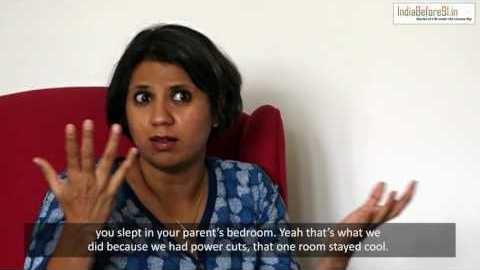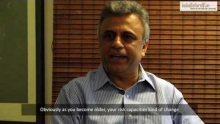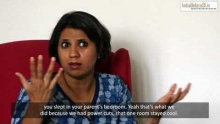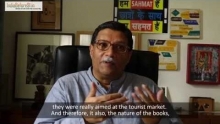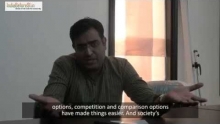Maya Mirchandani, Foreign Affairs Ed/Anchor at NDTV, recounts her experience of purchasing a Nikon FM2 with limited foreign currency. She discusses avenues for further liberalization, which can be developed with Public Private Partnerships, and private philanthropy.
Read the transcript below:
So we studied on a Nikon FM 2 camera at Sophia’s and we didn’t have the money for video equipment. I mean, we had the eumatic for the ad film that we made but for our film project we ended up doing an audio visual, a slide and script, slide and audio thing because we just didn’t have film cameras, the film cameras that we could access. When I started working and I had a regular salary coming in. I took my first foreign holiday abroad in 1996 and I went to meet my dad’s sister and brother in the United States. And I knew that what I wanted more than anything else was a camera, of my own. So I had done my research, I knew I wanted my FM2, I knew what lenses I wanted. I had to figure out how to gather the money for it because your foreign exchange had to enter on your passport. You can only take out a certain amount of foreign exchange. There were limits, it was I think it was like some 250 dollars or 300. I don’t even remember what it was. And you were opening up insofar as you could start bringing back electronic equipment that was for personal use, but you had to declare it. And every time you took it out of the country you had to enter it in on your passports the next time you brought it back in, no customs official would actually sign, make you pay duty on it. And I have my old passport books that still have the entry of my FM2 on exit and re-entry. So you know things like that. Today we only do that for a really heavy video equipment. I can take out my laptop, my iPad, my still camera, my phone, my iPod; as many gadgets that I am using for my personal use, I don’t need to enter it on my passport. I walk in and walk out of international airports along with it. So yeah that was a very real change that initially you were sort of conscious of declaring everything that you had. Now even if I go up to a customs officer and I say, “Sir I have to declare this”, he will say “What is this?” It doesn’t even register. It’s only if it costs above a certain amount of money etc that you do those things. So yeah, in those ways things have changed. That’s just in terms of the equipment I use today. But life has changed in the smallest of ways. I work in a newsroom where the younger generation is born after 1991. They are completely at a loss when we talk about the 80s. They have no idea what we are talking about. Well I think one of the things of liberalisation is that it’s been a great equaliser. Again I will go back to my childhood as an example. I grew up in 80s, we had a colour TV after 1986 and a VHS tape player, recorder VCR. We didn’t have a VCP; we had a VCR which way we could record as well as playback. Late in the 80s we had Star TV. We had one air conditioner in the house so in the hot summer all of us slept in my parent’s bedroom. It was like a waiting room, railway station. Even if we had cousins visiting, everyone would troop into the same bedroom. Today at least amongst my world and my universe, my staff has cell phones; the help in the house, my full-time help, her room has an air conditioner, a cooler. She has her own bathroom with a geyser, a heater in the winter. Whatever have you. Whatever “creature comforts” that we are now accustomed to, were very hard in my childhood. Nobody understands the concept of the fact that you only had one air conditioner, you slept in your parent’s bedroom. Yeah that’s what we did because we had power cuts, that one room stayed cool. There were no invertors, no generators. I mean the list is endless. The only fast food to Delhi, fast food is also was a relative term was Nirulas pizzas and that was a treat. It wasn’t something you walked in and out of all the time. There was no delivery. Look at the size of a hot chocolate fudge at Nirulas today. I say, what happened. It used to be in those big beer mugs and it was this large and now it’s this small. But times change, things change. That was then. I can be nostalgic about it but I know that where we are today is leaps and bounds ahead of where we were in terms of access to technology, access to consumer products, access to creature comforts, access to international cuisine, access to travel. So much has changed. So, I mean, I really don’t think that anything is bad about liberalisation. What brought me into journalism, in the first place was the need to be able to tell stories of people who didn’t have as much and where injustices lay in society. I don’t think those injustices have necessarily shrunk and I think that’s the real problem. While I am very happy that people who work with me or for me are able to enjoy creature comforts. I am also equally conscious of the fact that disparities have grown. You take a shopping mall in the city for example, you look at the kind of things that are available inside that mall and how inaccessible those things are to people who built that mall and continue to be. They live on site. Construction labour I think is where you see it the most, the disparity is the most visible. They are building these tall gleaming towers. But how are they ever going to have access. So I think, while the economy has liberalised, while we have opened our own intellectual horizons tremendously over the years, it is still incumbent upon us to help fill those gaps. And I don’t know where that responsibility lies. I think there has to be some aspects of public-private partnership. I do wish in terms of a society, our big industry would have a more philanthropic bent. You are seeing that also. You are seeing business also trying to fund the arts, trying to fund education. But I wish there would be more of that.
